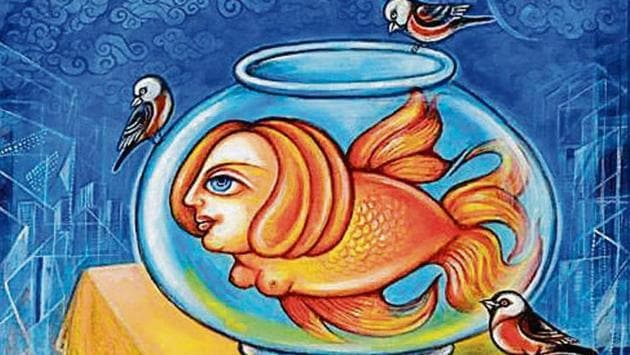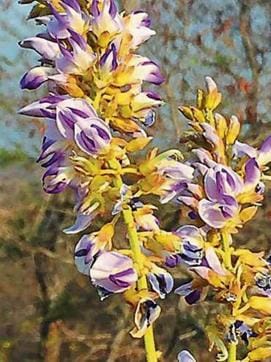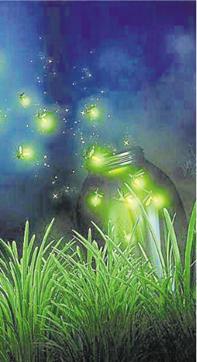Wild buzz: Sea in a mermaid, April’s cool ‘phools’ and the magic jar
Memories of our childhood, that fleetingly appear and vanish like the fireflies of darkness, sprang to life at the Sukhna’s lapping edges.
This week’s Wild Buzz talks about Kavita Singh’s ‘Mermaid in the fish bowl’, mysterious crowns of Wisteria sinensis (albiflora) and fireflies:

Sea in a mermaid
If you ever wondered what a lone goldfish in a bowl may feel as the world ogles her and glides past, let your mind revel in a startling work of art, ‘Mermaid in the Fish Bowl’, by painter, author of two books and assistant professor Kavita Singh. On display at last week’s All India Women Artists’ Contemporary Exhibition organised by Artscapes, the painting was a part of her feminist series, ‘Mermaid in the Urban Jungle’.
Modeled on herself, Singh’s mermaid finds she is trapped in glass bowls and malls for display as an object of desire. Snared in classy environments where onlookers and predators are constantly satisfying their bestial cravings, the mermaid looks at winged birds of freedom and undertakes a silent dialogue with them. The birds, as lesser beings, are free while the woman’s life, seeded with great potential by education and empowering laws, yet remains circumscribed. She yearns to free herself from the clutches of her fancy cell. The sky in the background is cast with dense, brooding clouds. “Her desires, aspirations, hopes have been contained in a small ocean called the glass bowl,” Singh told this writer.

April’s cool ‘phools’
From afar, as you walk the Shivalik ridges of the Siswan Community Reserve, the eye chances upon a jungle graced by sporadic daubs of lilac or jacaranda tree crowns. But as the tree looms up and close before the jungle’s pilgrim, lilac diffuses to stacks of delicately-coloured purple, mauve and white flowers. The trees themselves are stumpy with wayward branches and certainly not jacaranda.
The mysterious crowns are of Wisteria sinensis (albiflora) a woody, deciduous, perennial climbing vine flowering in March/April. “Wisteria gives the tree a beautiful crown of flowers after having entwined around it. But it can kill the host tree after having secured its needs,” SP Khullar, former head of Panjab University’s (PU) botany department, told this writer.
Wisteria is no son of the Shivaliks soil, it is cunning and pretentious. “Wisteria was native to China but shipped to England in 1816 and became a popular ornamental in the nursery trade. It is trained along garden walls, along the exterior of buildings, or over a pergola to create avenues of overhanging blossoms. The area where it has been found by you is just below Kasauli heights. It is possible that some European, who had a fancy for this flowering vine, brought it to Kasauli which was then a convalescence station for British soldiers injured during World War 2. The plant did well at Kasauli and escaped from cultivation, seeds moving downwards via wind, water or bird droppings, and found a congenial place to germinate in Siswan,” explained Khullar.
The magic jar
As the moon ripened to fullness on Saturday, the imaginative eye would have made out an antlered stag or a hare with long, upright ears emblazoned on the celestial orb.

The 12th century’s Sanskrit poet, Jayadeva, must have also gazed upon the full moon and thus inspired, written tender love verses of Radha-Krishna. “With deer musk he draws the form of a stag on the moon/He makes star clusters with pearls and a moon mark with his nail,’’ wrote Jayadeva in ‘Gita Govinda’.
Centuries later, the same full moon beamed on the Sukhna lake’s waters. At first glance, walkers may have mistaken flitting sparkles to be the moon’s silver reflections tossed on murmuring eddies. But the sparkles were actually the season’s first wave of fireflies. The flickers were also hard to identify instantly because these insects have been reduced to rarities, doomed by bright lights, urbanised nights.
Memories of our childhood, that fleetingly appear and vanish like the fireflies of darkness, sprang to life at the Sukhna’s lapping edges. Fireflies would never have been so enigmatic were their lights steady and not hide-and-seek or disappearing acts! Decades ago, kids would chase ‘night guides’ across fields and gardens, cage them in glass jars and walk gleefully in darkness with these jars, like explorers holding aloft ‘mashaals’ (flame torches) and daring eerie caves. Some kids would set them free, others would leave fireflies to their doom by junking jars after having enjoyed the thrill of lights aflutter in tingling, cupped palms. It was magic, it was real.
Fireflies are diamonds of a healthy nocturnal environment. However, their presence has ebbed from our ‘beautiful, flashy’ gardens brimming with exotic plants due to insecticides, light pollution and lack of undisturbed leaf litter, natural water-bodies and native flora.
vjswild1@gmail.com



